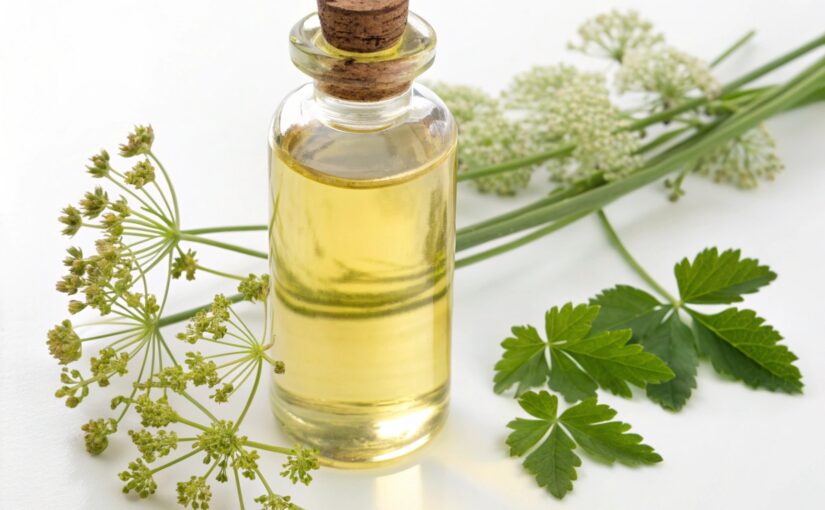Angelica archangelica, a member of the Apiaceae family, is native to the moist, fertile regions of Europe and Siberia. The essential oil is typically obtained by steam distillation from either the roots or seeds of the plant. Root-derived oil starts out colorless and ages to yellow or dark yellow, with a rich, earthy, herbaceous aroma. Seed oil presents as clear to pale yellow and offers a fresher scent with musky, peppery-green, and spicy notes. Both oils possess stimulating and mildly aphrodisiac qualities credited to their chemical composition, which includes angelicin, bergapten, phellandrene, borneol, camphene, caryophyllene, limonene, myrcene, and pinene, alongside a variety of beneficial terpenes.
History and Cultural Significance
Angelica has been regarded as a sacred plant since the Middle Ages, named for the Archangel Michael and widely known as the “holy spirit root.” It earned legendary status for its perceived ability to ward off the plague and protect against evil. Its history encompasses rites of purification and healing in Europe, China, Africa, and North America. Angelica’s edible stems have flavored iconic herbal liqueurs, such as Chartreuse and Benedictine, while its roots and seeds are cherished in candied confections. The plant is visually striking, with tall stalks and yellow-green blooms, thriving in damp soils and often flowering near Saint Michael’s feast day in May. Its symbolic role as a guardian and bringer of divine protection is woven throughout its storied legacy.
Therapeutic Benefits
Angelica essential oil serves as a multifaceted healing agent, valued in traditional and holistic medicine. Among its notable benefits are antibacterial, anti-infectious, and antiviral actions that support immune defense and help manage conditions like colds, influenza, bronchitis, and urinary tract infections. The oil’s anti-inflammatory and antiseptic properties lend themselves to the soothing of skin conditions including psoriasis and roughness, as well as arthritis relief and the promotion of wound healing and scar reduction.
As a carminative and digestive tonic, angelica oil helps ease colic, indigestion, stomach cramps, and stimulates appetite, making it especially beneficial for those recovering from illness or combating anemia. Its decongestant and expectorant qualities clear mucus, reduce respiratory congestion, and help alleviate coughs and asthma symptoms. Acting as a diuretic, the oil encourages lymphatic drainage and decreases fluid retention.
One of angelica’s most celebrated effects is its capacity to regulate menstrual cycles and relieve PMS and menopause symptoms, earning it the affectionate nickname “woman’s ginseng.” As a nervine and tonic, it assists in reducing fatigue, nervous tension, and nicotine cravings. Inhalation of the oil may help decrease the frequency of cravings, supporting those seeking support in addiction recovery. Emotionally, angelica is grounding and restorative, nurturing sweet dreams, offering emotional protection, and encouraging spiritual trust.
Aromatherapy Applications
Angelica essential oil has various uses across aromatherapy. For inhalation and diffusion, four to six drops in a diffuser with water can clear airways and uplift mood. In massage and topical applications, blending ten to fifteen drops with a carrier oil such as almond brings relief to arthritis, rheumatism, and promotes healing for wounds. For respiratory support, it can be combined with eucalyptus and used as a chest rub. Adding the oil to bathwater aids urinary, menstrual, and relaxation concerns. As a sleep aid, a drop placed on the soles of the feet before bedtime supports restful, dream-rich slumber.
Spiritual Significance
Angelica is often described as an oil of spiritual opening and alignment, serving those who seek harmony and connection with the divine. Users turn to angelica essential oil to clear spiritual senses, deepen trust in higher guidance, and ground their spiritual nature into daily life, striving for “heaven on earth.” It is employed to strengthen inner guidance, foster connection with loving spiritual beings, and support the full flowering of the soul. The oil is particularly helpful for emotions revolving around spiritual disconnection, distrust, lack of faith, and feelings of spiritual manipulation.
Blending Suggestions and Companion Oils
Angelica essential oil blends well with numerous herbaceous and aromatic oils. Popular choices include bergamot, chamomile, frankincense, geranium, ginger, grapefruit, lavender, lemon, mandarin, patchouli, valerian, yarrow, and spikenard. Companion oils like yarrow, frankincense, and spikenard are frequently used to enhance angelica’s grounding and protective properties. These blends are designed to broaden the scope of healing and emotional effects in aromatic routines.
Safety and Precautions
When using angelica essential oil, certain safety considerations should be observed. The root oil is phototoxic and may cause skin pigmentation if exposed to sunlight; avoidance of sun for twelve hours after topical application is recommended. Patch testing is advisable to check for sensitivities, and use is not recommended during pregnancy due to its emmenagogic effects. Moderation in use is essential, as the oil is potent and a small amount goes a long way.
Angelica essential oil is a sacred botanical resource that expertly bridges the realms of physical healing and spiritual awakening. From soothing common ailments and supporting women’s health to fostering emotional resilience and spiritual trust, angelica invites harmony, protection, and connection with the divine into daily life. Its potent legacy and versatile benefits continue to be celebrated by those seeking both material and transcendent wellness.
If your heart finds joy and inspiration here, consider supporting the work that keeps these stories blooming. Your donation, no matter the size, helps sustain authentic research, creative writing, and the spirit of sharing that connects us all.
